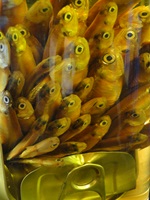Ichthyology Resources
Online Database

The ANSP Ichthyology Online Collection Database contains 129,122 records of specimens from the collection.
Ongoing Projects

 |
For the next year JGL will continue systematic studies of freshwater fishes, including new species descriptions, taxonomic revisions and phylogenetic analyses of South American pimelodid catfishes and another poorly-known Mexican blind catfish.
New work has just begun on an undescribed fossil catfish of Eocene age from the South Dakota Badlands.
|
Policies

Collection Access
Achievement of the Ichthyology’s missions in research, teaching and service demands that the fish collections be easily accessible. At the same time, the fish collection consists of fragile and irreplaceable specimens, which means that protection and preservation of the collection are central to the staff’s curation activities. The policy on access to the collection thus attempts to achieve a balancing between the goals of easy access and protection.
The fish collection is open to all visitors between 8:30 am and 5:00 pm Monday through Friday (except statutory holidays). After hours and weekend use can be arranged if necessary. All visitors must sign in at the museum security desk and be escorted to the collection wing of the building. Visitors should sign the visitors’ book.
Qualified individuals may use the collections; Ichthyology staff will assist novice users until the individual has become familiar with standard protocol for handling specimens. Visitors may use workspace and microscopes provided in visitor labs on the first floor or newly renovated work areas in the mezzanine and basement collection rooms. Visitors may use one of the general use networked computers (PC and Mac) in the Ichthyology (1st floor). Plug-ins for personal laptop computers are also provided. These computers allow access to databases both at the Academy and other institutions. High-resolution digital photography and X-radiography can be provided in Ichthyology’s imaging center.
Our holdings of specimen lots in jars are organized by orders and families with genera and species shelved alphabetically. The tank specimens are similarly ordered but of necessity there are some tanks with mixed families. All tanks are boldly labeled and lists of contents are available. The dry and cleared and stained specimens are respectively in separate cabinets or shelved area. Type specimens are in a separate area on the mezzanine level.
The Ichthyology Department maintains a significant collection of reference books and reprints from both the main ANSP Library and the Böhlke Library for use by staff and visitors. These books do not normally leave the department. The main or Ewell Sale Stewart Library contained within the Academy houses an extensive collection of zoological and ichthyological reference books and journals. The library allows reference materials to be used within the Academy with the appropriate permission.
Loans
The Ichthyology Department loans materials to institutions and professional researchers, provided that adequate facilities are available for care of the specimens while on loan. Primary type specimens are no longer loaned out. Loans are normally for a one-year period, extendable upon request. Loans are managed using an Access database and a file system.
Specimen Accession
Because of the resources involved in permanent curation of fish specimens, only those of high quality with good documentation are accepted. Proof of legal collecting or other method of procurement of fish specimens is required for their accession. The template of our accession invoice is appended.